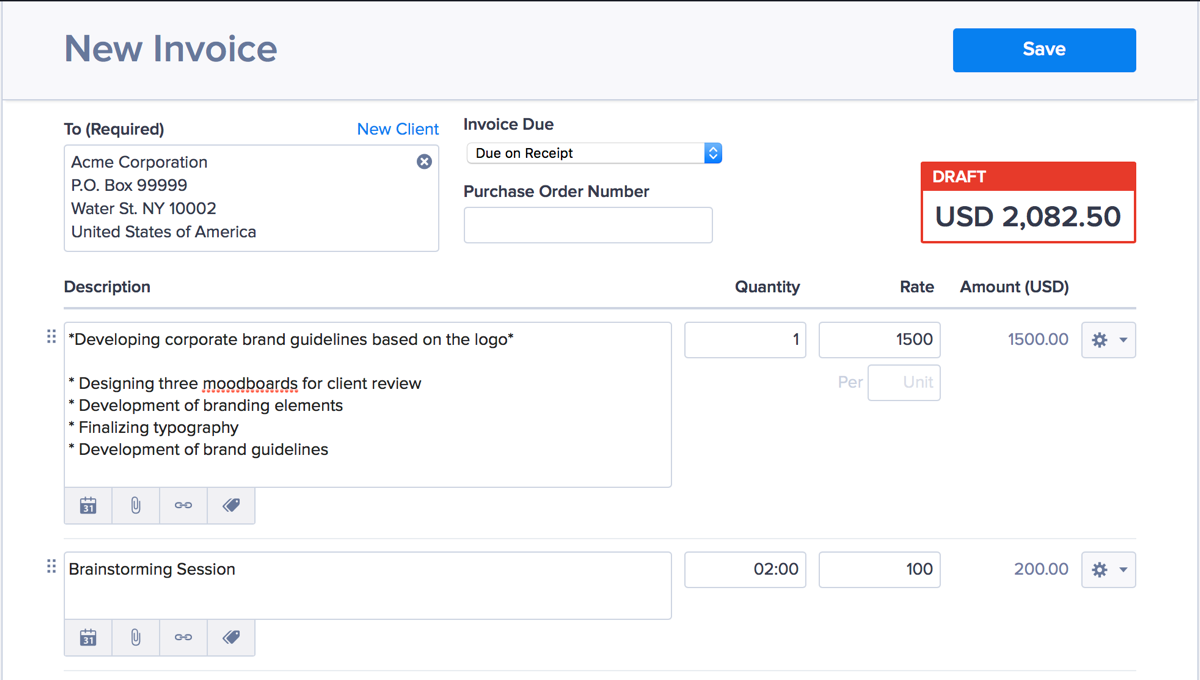Parts of an Invoice: What an Invoice Must Contain
When you first start creating invoices, it can certainly be overwhelming. This is especially true since many invoices will differ depending on the work you’ve done, the requirements of you and your client, and whether you are creating consolidated invoices. However, there are several key elements you need to include in every invoice—for both ad hoc invoices and recurring invoices.

You can think of these as your invoice’s ‘baseline’ – the most important information for both you and the recipient. By making sure you include these in every issued invoice, you’ll have a good template to build from.
A better way to manage your finances
With Hiveage you can send elegant invoices to your customers, accept online payments, and manage your team — all in one place.
In this article, we’ll show you the eight key elements you’ll need to show on every invoice. We’ll also touch on how you can make entire payment process easier by using invoicing software such as Hiveage. Let’s get started!
8 Essential Parts of an Invoice All Your Invoices Must Contain
Of course, your invoice will usually contain every element required by your clients, and this will sometimes be dictated by geographical or government-specific laws and regulations. However, our first element is firmly grounded in common sense.
1. Clearly Mark Your Invoices as Such
This first item is an easy one. This simply means including the word “Invoice” on your invoice. While this could seem obvious, it’s actually very important to make its purpose clear. For example, clearly marking your invoice will avoid situations where people may confuse it for a receipt, statement, or estimate.
As you read through these elements, remember that your main goal should be to get paid as quickly as possible once an invoice is issued. As such, you’ll often notice that your template will need adjustment in some way if payment times are overly long.
2. Add a Unique Invoice Number
An invoice ID number, or simply invoice number, is a unique string that identifies a specific invoice. These usually have a predetermined format, including a prefix and a series of numbers. Invoice IDs are most commonly associated with recurring billing.
However, they’re still extremely important to include, even on one-off invoices for your own records and your clients’. By assigning a unique identifier to each invoice, you can easily refer to previous invoices and it makes it much simpler to track the work you’ve done with different clients.
3. Include Accurate Cost Amounts
Naturally, you need to tell your client what they need to pay. However, alongside the total sum, you should also break down the costs into individual amounts for each aspect of the work you’ve done.
For instance, if you’ve designed both a website and logo for a client, you should outline what each task cost. This will help them get a clearer idea of what they’re paying for and how the final figure was calculated.
4. Make the Payment Terms Clear
In addition to telling them what they should pay, you also need to make it clear how they should do it. You can use this to inform them of whether partial payments are allowed, what payment methods you use to collect payment, and when you want them to pay (i.e., due date)
Being clear at this stage will help avoid caused by uncertainty or delays in payment. As we mentioned, the easier it is to pay an invoice, the quicker you’ll receive the money.
5. Supply Payment Details
Of course, you also need to give your client the details they need to complete the payment. For example, this could include your account details and sort code, or your PayPal address.
As before, providing all the information and details at this stage will make it easier for your clients to complete the payment on time. It also ensure each payment is completed according to your requirements.
6. Include All Relevant Dates on Your Sales Invoice
Your invoice also needs to contain accurate date information. This includes the following:
- Supply date: When you delivered the service or product to the client.
- Invoice date: When you sent the invoice.
- Payment due date: Deadline for paying the invoice.
It’s naturally also important you make relevant dates completely clear, in order to avoid misunderstandings.
7. Include a Summary of the Invoiced Product or Service
You should include a description of what exactly the invoice is for. The purpose of this is to clearly outline which product or service you have provided to the client.
Make sure you’re as specific as possible here, as this will help those responsible for processing the invoice to know exactly what they’re paying for. Avoid vague comments such as “Provided various services” and focus on the actual deliverables.
8. Provide Personal Information for You and Your Customer
Finally, you should make sure to add all relevant personal information about both you and your customer. For you, this includes your name, address, and contact information at a bare minimum. When it comes to the client, you should at least include their company name and address.
You can add additional information as well, as appropriate, such as tax ID numbers. However, avoid adding unimportant filler, as this could make the invoice difficult to read.
How to Easily Create and Manage Professional Invoices
Even though there are a fair few things you need to consider, creating a functional invoice template doesn’t have to be difficult. To make life easier for yourself, you should consider using dedicated software like Hiveage for creating electronic invoices.
With this, you can easily create professional invoices using templates, which ensures all the relevant information is included every time. You can even use this to send out receipts and reminders from the same interface, keeping everything in one tidy spot.
Ultimately, this helps you create consistent and comprehensive invoices, and streamline your invoicing process. This will help you save time, as you can easily track which invoices you’ve sent and are awaiting payment for, while your clients will get clean, functional invoices containing all the information they require to pay you promptly.
Conclusion
Creating invoices can be a frightening task if you have limited experience in the field, but it doesn’t have to be. By understanding the core anatomy of an invoice and knowing what the bare minimum requirements are, you can easily create and send functional invoices.
In this article, we’ve outlined the elements that any invoice must include. These include clearly labeling your invoices, including the details of both your client and yourself, summarizing the actual services you provided, the total cost, and more.
Do you have any questions about how to construct an invoice? Let us know in the comments section below!
Join thousands of business-savvy entrepreneurs on our mailing list.
Curated emails that’ll help you manage your finances better.




